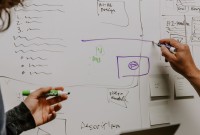- Home
- Business Processes
- Industry Knowledge
- Aerospace Industry
- Automotive Industry
- Banking Domain
- BFSI Industry
- Consumer/ FMCG Industry
- Chemicals Industry
- Engineering & Construction
- Energy Industry
- Education Domain
- Finance Domain
- Hospitality Domain
- Healthcare Industry
- Insurance Domain
- Retail Industry
- Travel and Tourism Domain
- Telecom Industry
- Leadership Skills
- eLearning
- Home
- Leadership
- Leadership & Management
- Theories of Team Development
Theories of Team Development
The development of teams is an ongoing process because the composition of the team may keep on changing. The new members may join and the old members may leave the team. The team members pass through several stages for the development of the team and there has been a lot of research to identify these stages. In this article, we discuss the common theories of team development.
Team is formed as a result of interactions and influence of members who strive for the achievement of common goal. After the formation the teams take time to develop and usually follow some easily recognizable stages, as the team-members transition from being a group of strangers to becoming a unified integrated team chasing a common goal. In this process, the team members try to understand others behavior, realize the appropriateness of the behavior and the roles of the team members. A team is not formed merely by declaring some individuals as a team. A lot of research has been done on group formation and development, and different theories of group development have been suggested. Given below is a list of commonly known theories on team/group development:
- Bennis & Shepard, 1956;
- Bion, 1961;
- Gibb, 1964;
- Schutz, 1958, 1982;
- Tuckman, 1965;
- Tuckman & Jensen, 1977;
- Yalom, 1970;
- Tuckman, 1977;
- Kormanski & Mozenter, 1987;
Now we will discuss some popular theories on team development in detail:
Tuckman’s Five Stage Team Development Model:
Psychologist Bruce Tuckman first came up with the memorable phrase "forming, storming, norming, and performing" back in 1965. The “Forming – Storming – Norming – Performing” model of group development maintained that these phases are all necessary and inevitable in order for the team to grow, to face up to challenges, to tackle problems, to find solutions, to plan work, and to deliver results. This model has become the basis for subsequent models. He used it to describe the path to high-performance that most teams follow. Later, he added a fifth stage that he called "adjourning." Let us learn the five stages briefly:
Forming: This is the first stage of team development. In this stage the members try to explore and understand the behavior of the team members. They make their efforts in understanding the expectations of the team members. At this stage they are polite and try to find out how to fit into the team.
Storming: In the second stage, members start competing for status, leadership and control in the group. Individuals understand others behavior and assert their role in the group. As a result inter-personal conflict starts. Members try to resolve the issues related to the task and working relations. They also resolve the issues related to the role of the individual in the group.
Norming: The members start moving in a cohesive manner. They establish a balance among various conflicting forces. They develop group norms and consensus for the achievement of the group goal. At this stage, cooperative feelings develop among the team members.
Performing: In this stage, the team makes effort for the performance of task and accomplishment of objectives. The established pattern of relationships improves coordination and helps in resolving conflicts. Members trust each other and extend their full cooperation for the achievement of the group goal.
Adjourning: As you must be aware that the team is formed for some purpose. When this purpose is fulfilled, the team may be adjourned. Thus, the breaking up of the team is referred to adjournment.
Kormanski & Mozenter (1987) Stages of Team Development:
Kormanski & Mozenter (1987) integrated the various theories and suggested the following stages of team development. These stages are sequential (each stage is followed by the next one). Each stage has a task outcome and a relationships outcome. Kormanski and Mozenter have identified following stages of team development :
- Awareness
- Conflict
- Cooperation
- Productivity, and
- Separation
1. Awareness: At this stage individuals get to know each other. By knowing the goals of the team they commit themselves to the goals. The members get to know and accept to work together for a goal about which they have enough knowledge.
2. Conflict: At the first stage (awareness) the members know the team goals and accept to work together; but this is at the surface level. At the second stage they search and begin to ask questions. As a result several matters are clarified. They also fight with each and in this process of interaction resolve any hostilities they may have, resulting in the feeling of belonging to the group.
3. Cooperation: In the third stage the members own the team goals and get involved in those goals. Having resolved feelings, they also support each other.
4. Productivity: This is the stage of real achievement of the goals/outcomes, and the team members achieving these objectives feel proud of their achievement.
5. Separation: Having accomplished the goals or the outcomes, some task-specific teams may decide to get dissolved, or a time-bound time comes to a close. The excellent work done by the members is recognized, and the team members have a high sense of satisfaction of working with each other. This is the stage of closure of the team, or closure of one task on which the team was working.
The following table provides a summary of task outcomes and relationships outcomes at each stage as defined in the model:
|
A Model of Team Building |
|||
|
Stage |
Theme |
Task Outcome |
Relationship Outcome |
|
One |
Awareness |
Commitment |
Acceptance |
|
Two |
Conflict |
Clarification |
Belonging |
|
Three |
Cooperation |
Involvement |
Support |
|
Four |
Productivity |
Achievement |
Pride |
|
Five |
Separation |
Recognition |
Satisfaction |
Related Links
You May Also Like
-
What are the functions which a leader does to establish as a leader? What are the activities undertaken by them to become great leaders, rather revolutionary leaders? The most important tasks done by a leader in all situations are defining the vision, mission, and goals, leading the team, administrative functions, motivating followers, decision making and conflict resolution, and continuous development.
-
McGregor's Theory X and Theory Y
McGregor created Theory X and Theory Y of human work motivation and explained two styles of management known as authoritarian (Theory X) and participative (Theory Y). Theory X management assumes most people will attempt to avoid work whereas Theory Y managers trust their people to take ownership of their work.
-
Maslow's hierarchy of needs is a motivational theory that explains that people are motivated by five basic categories of human needs. These needs are physiological, safety, love and belonging, esteem, and self-actualization. There is a little scientific basis for this concept of a hierarchy of needs.
-
Have you ever resonated that there seem to be as many different ways to lead people as there have been great leaders? When we recall the success of Mahatma Gandhi, Nelson Mandela, Abraham Lincoln, Napoleon Bonaparte to Steve Jobs and Jack Welch, we also notice that they all used different approaches that were suitable to their specific situations and circumstances. Over the last century, researchers and psychologists have developed simple ways to describe the “Styles of leadership” and in this section, we will explore these commonly known leadership styles.
-
Transactional Theory of Leadership
Transactional leadership theory is based on the concept of rewards and punishments. The transactional management approach assumes that the desires of the leader and follower are different and leaders give followers something in exchange for getting something they want. Transactional leaders expect followers to be compliant and focuses on structure, instruction, monitoring, organization, or performance to get tasks completed on time.
-
The Systemic Approach to Leadership
The systemic approach to leadership looks at the organization as a whole and focuses on the understanding of the organization as a system. Moving to systems thinking demand managers to view organizations as organic systems. Leaders are also part of this complex system which is constantly undergoing change and evolving. The leaders need to manage the relations and networks within these systems by acting with systemic awareness.
-
Action Centered Leadership is a model developed by John Adair and focuses on the three responsibilities of a leader which are achieving the task, managing the team, and managing individuals. All these action elements are mutually dependent and important for any leader.
-
Role theory is a concept in sociology and the role theory of leadership borrows these concepts to explain how people adapt to specific organizational and leadership roles. How the leaders and followers in an organizational context define their own roles, define the roles of others, how people act in their roles and how people expect people to act in their roles within the organization.
-
Authentic leadership is a new approach to leadership in which leaders are genuine, self-aware, transparent, build honest relationships, and work on an ethical foundation. Authenticity is one of the core values of leadership. Authentic leaders have truthful self-concepts and they inspire by promoting openness by acting in a real, genuine, and sincere way. Authenticity requires self-awareness and the ability to act in accordance with one's true self.
-
Contingency Theories in Action
Contingency theory suggests matching the best leader to a specific situation based on situational factors and the leadership style. The practical application of theory can be done in various ways. The workplace example is to determine the best candidate for a given set of requirements using the LPC score. Applying the model to determine a leader's ability to adapt in the scenario of a new project etc..
Explore Our Free Training Articles or
Sign Up to Start With Our eLearning Courses

About Us
Learning
© 2023 TechnoFunc, All Rights Reserved










